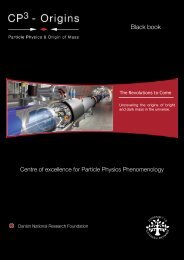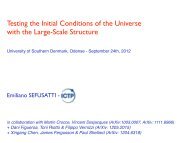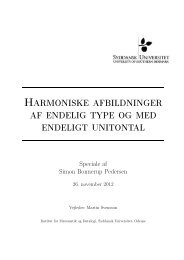PhD thesis - CP3-Origins
PhD thesis - CP3-Origins
PhD thesis - CP3-Origins
Create successful ePaper yourself
Turn your PDF publications into a flip-book with our unique Google optimized e-Paper software.
Chapter 4.TechnicolorAn attractive feature of dynamical electroweak symmetry breaking is that it does notsuffer from the naturalness, hierarchy and triviality problems like the elementary scalarHiggs in the SM. In order to understand that large separation of scales arises naturallyin asymptotically free, strongly coupled theories, let us solve equation (3.3) for a largescale Λ in terms of the bare couplingΛ QCD = Λe −8πg (0)s b 0 . (4.1)If we take the scale to be the Planck scale, a coupling of order g s(0) ∼ 0.4 will generatea strong coupling scale Λ QCD ∼ 300 MeV. Therefore, the scale of symmetry breakinggenerated by the dimensional transmutation is naturally exponentially smaller than thecut-off of the theory.In technicolor theories new massless fermions, so called techniquarks, are includedinto the SM without the Higgs sector [34, 35]. They feel a new QCD-like strong force,corresponding to a gauge group SU(N TC ), which causes the formation of techniquarkcondensate breaking the global chiral symmetry G down to H ∈ G. In order to achievecorrect breaking of the electroweak sector, SU(2) L × U(1) Y group has to be embeddedproperly into G, as discussed in Section 3.5.There is an intriguing similarity between superconductivity and technicolor. TheSM with the minimal Higgs sector corresponds to the Ginzburg-Landau theory andtechnicolor would correspond to the BCS theory.35








